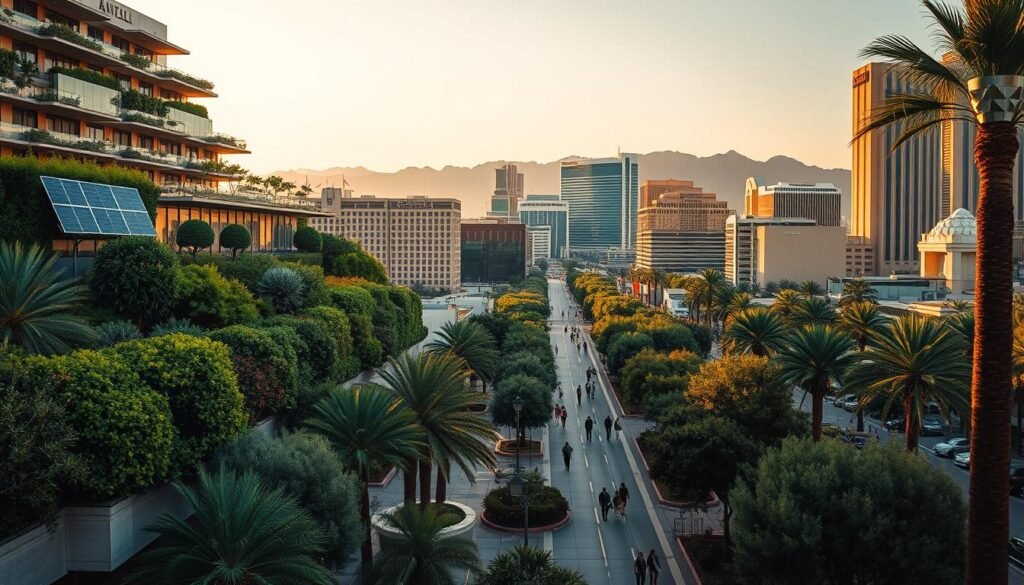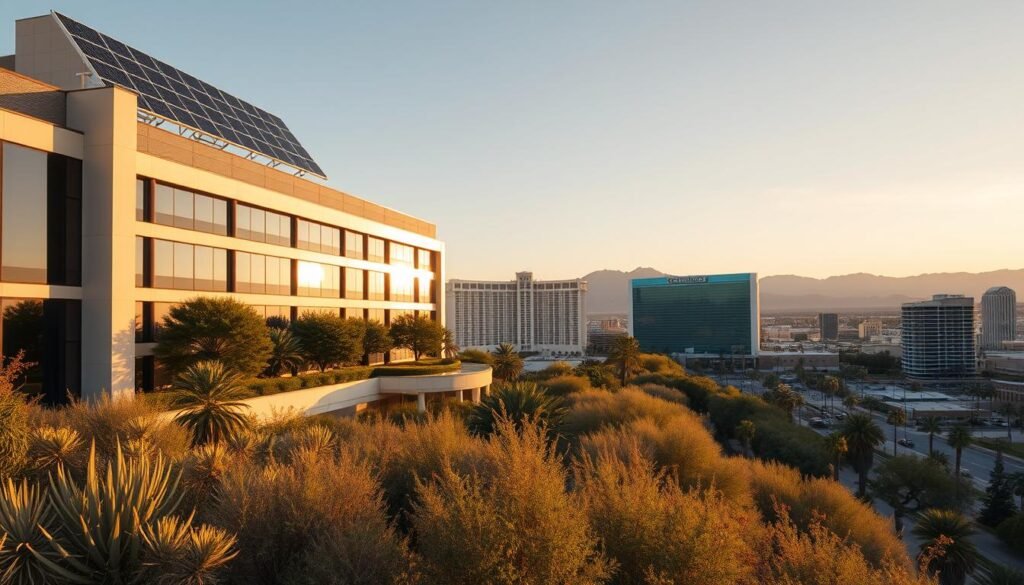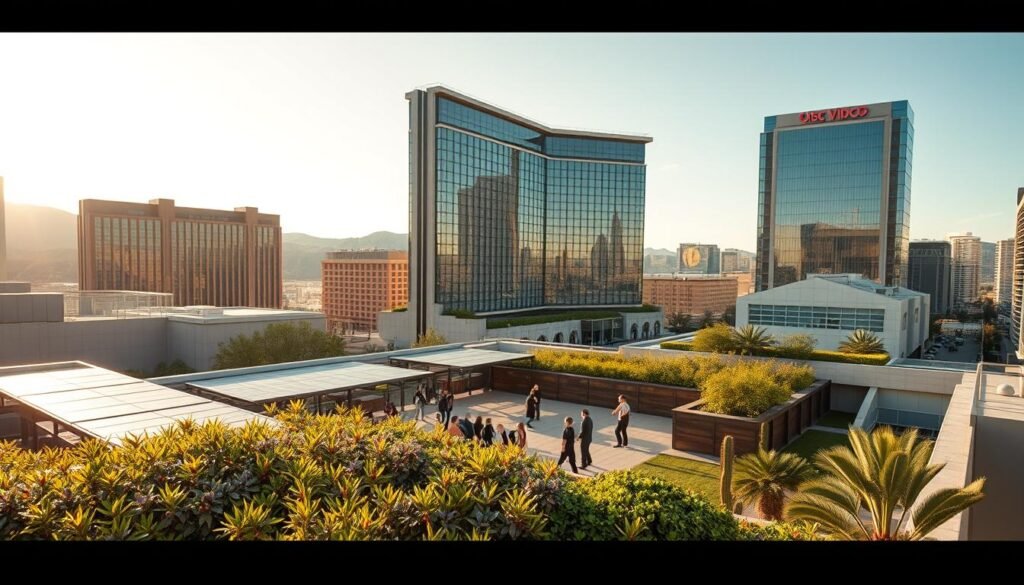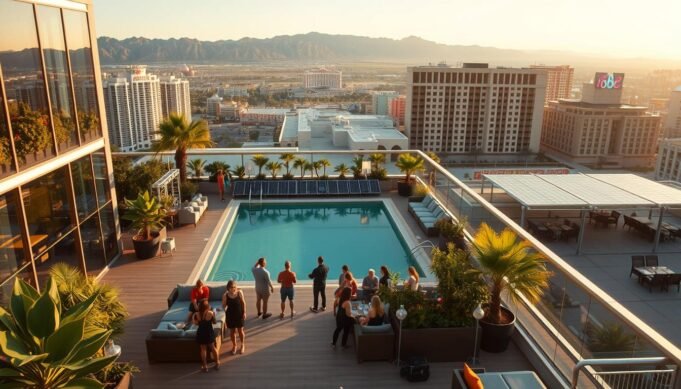Surprising fact: the average hotel in North Las Vegas emits 18.9 kg CO2 per night. That number surprised me — and it should surprise you too.
I love a glitzy getaway as much as anyone, but I also want my choices to matter. This short guide shows how picking the right hotel can cut your footprint below that 18.9 kg mark.
We lean on numbers, certifications, and live data from Staze. You’ll get clear information on who is lowering energy use, saving water, and reducing waste — without losing the fun that draws travelers to the city.
Expect real examples, simple explanations, and practical tips that make sustainability feel doable. I’ll point out which places invest in smarter systems and why that matters for tourism and the broader market.
Key Takeaways
- Average footprint: 18.9 kg CO2/night is the baseline for North Las Vegas.
- Choosing the right hotel can cut your footprint noticeably.
- We use verifiable metrics and certifications, not guesswork.
- Sustainability can coexist with great food, shows, and pools.
- Small choices by travelers drive demand for a greener market.
How We Chose the Most Sustainable Stays in the City
I don’t trust brochures — I follow data, systems, and observable practices that cut energy and water use. My approach looks at building design and day-to-day operations. That means checking certifications, measured emissions, and the actual management plans behind each property.
What “sustainable” means on the ground
Energy efficiency is first: smart rooms, LEDs, cogeneration at ARIA, and solar-thermal at The Venetian show long-term thinking. Water conservation follows — low-flow fixtures, well-water reuse at Bellagio, and recycled water systems keep pools and fountains running with less strain.
Recognized standards and real data
We favor globally recognized badges — LEED, Green Key, Green Globes — and hard numbers like carbon emissions per room night from Staze. Operations and management matter too: CodeGreen, ISO certifications at Crockfords, and Resorts World’s renewable power prove ongoing commitment.
Bottom line: I choose properties that pair certified building credentials with daily practices you can see — trained teams, regular audits, and published information — so your stay truly lowers impact.

Best eco-friendly hotels in Las Vegas
If you want big-city glamour that actually cuts resource use, these properties prove it’s possible.
ARIA Resort & Casino — LEED Gold, five Green Keys, smart-room energy savings, low-flow fixtures, and food-waste-to-biofuel programs. Back-of-house cogeneration and CNG transport show deep operational commitment.
The Venetian Resort — part of the largest LEED-certified meetings venue, with rooftop solar-thermal and high recycling rates that keep waste streams lean.
The Palazzo — LEED-certified operations, energy-efficient lighting, and comprehensive water-saving technologies that preserve comfort while cutting use.
Bellagio — five Green Keys and four Green Globes; on-site well water feeds the fountains, advanced treatment saves millions of gallons, plus robust recycling and composting.
Park MGM & The LINQ — Park MGM taps an MGM solar array, water recycling, and waste diversion. The LINQ brings a Green Key eco-rating, energy-efficient tech, eco-cleaning, and steady recycling for guests who want low-impact service.
Resorts World (Conrad, Hilton, Crockfords) — LEED Gold buildings powered by 100% renewable energy, water-efficient fixtures, multi-stream recycling, and ISO certifications at Crockfords.
Other picks — Caesars’ CodeGreen properties, Virgin Hotels aligned with Hilton goals, The Signature’s Green Keys and Globes, plus budget and boutique options like Staybridge Suites and Holiday Inn Express that lower carbon and emissions without sacrificing style.

Sustainable travel in Las Vegas: practices, activities, and guest experiences
I found that sustainable travel around this desert city is less about sacrifice and more about smarter choices. Small shifts by properties and the city make your trip feel lighter and more meaningful.

Citywide initiatives are real: tighter water rules, better recycling streams, and energy-efficient operations at major venues. These moves cut waste and make everyday tourism choices easier for travelers.
Nearby activities bring conservation to life. Hoover Dam tours show renewable energy at scale. Red Rock Canyon offers guided hikes, cycling tours, and wildlife viewing that teach stewardship up close.
Dining with a lighter footprint is also growing. Local, organic, and plant-forward menus reduce food waste and support area growers. Ask for refill stations, smaller portions, or composting options—restaurants will often help.
- Look for clear marketing that lists certifications, solar use, and water savings.
- Pick properties that train staff on waste reduction and guest engagement.
- Share preferences at check-in to get tips on low-waste tours and dining.
“These practices aren’t a trend; they’re a promise to future generations.”
If you travel with that mindset, you’ll enjoy big-city experiences while helping protect the area—and you might bring better habits back home.
Conclusion
You can chase bright lights and still choose stays that cut carbon and waste. The bottom line: your choice of resort or property shifts the market. Pick places with clear initiatives, measured carbon emissions, and strong operations and management.
Look for LEED buildings, rooftop solar-thermal, and renewable energy at scale. Those technologies and efficiency upgrades reduce water use, lower emissions, and keep comfort high.
Use the information here when you book. If you want more detail on specific practices, check a short guide to smoke-free options and sustainability that highlights measured initiatives.
Travel well. Support properties that report progress, not promises — and take a few habits home so your good intentions have lasting impact.
FAQ
What makes a stay in Las Vegas genuinely sustainable?
A truly sustainable stay blends energy efficiency, water conservation, and strong waste management. Look for properties with LEED, Green Key, or Green Globes recognition, measurable carbon emissions reductions, on-site renewable energy, and programs that cut food waste and boost recycling. Those elements signal a property actively shrinking its environmental footprint while keeping guest comfort high.
How do hotels measure and report their energy and carbon performance?
Many properties use utility tracking, energy-management systems, and third-party audits to measure consumption and carbon emissions. Certifications like LEED and ISO 50001 show verified performance. Chains often report renewable energy sourcing, efficiency upgrades, and emissions data in sustainability reports so travelers can compare properties.
Are the sustainability features at major resorts noticeable to guests?
Yes — you’ll often see smart-room controls, low-flow fixtures, energy-efficient lighting, reflective window films, and clear recycling stations. Some resorts highlight solar arrays or water-recycling systems in public areas, and many offer digital info about their conservation efforts so you can choose practices that match your travel values.
Can a luxury property also be low-impact?
Absolutely. Several high-end resorts combine upscale service with LEED certifications, multi-stream recycling, on-site renewable energy, and advanced water treatment for fountains and landscaping. Luxury and sustainability can coexist — it’s about design choices and operations that reduce emissions without cutting comfort.
How do budget and midscale brands contribute to environmental goals?
Budget and midscale properties often focus on energy reduction, efficient HVAC, LED lighting, and linen reuse programs to lower emissions and operational costs. These measures make a big collective difference and offer travelers lower-carbon options without sacrificing cleanliness or basic amenities.
What role does renewable energy play at local resorts?
Renewable energy — rooftop solar, large solar arrays, and utility-scale offsite purchases — helps properties meet carbon targets and sometimes power significant portions of operations. Resorts that source 100% renewable energy or host big solar installations markedly reduce their climate impact.
How important are certifications like LEED, Green Key, and ISO standards?
Very important. LEED verifies building-level sustainability. Green Key and Green Globes focus on hospitality practices. ISO 14001 and ISO 50001 certify environmental and energy management systems. These standards provide transparent benchmarks so you can trust a property’s claims.
Do on-property restaurants and dining options affect overall sustainability?
Yes. Restaurants that prioritize local, organic, and plant-forward menus cut food miles and waste. Kitchens that compost, donate surplus food, or convert waste to biofuel reduce landfill contributions and lower the hotel’s overall footprint — and often deliver tastier, fresher meals.
What should I ask the front desk if I care about conservation during my stay?
Ask about the property’s recycling program, towel/linen reuse policy, water-saving fixtures, and how they source energy. Inquire whether they offer vegetarian or locally sourced meal options and if there are ways to offset your stay’s emissions through verified programs.
Are there nearby eco-activities worth adding to my itinerary?
Definitely. Visit Hoover Dam to learn about renewable energy and water management, and explore Red Rock Canyon for conservation-focused outdoor experiences. These visits deepen your connection to the region’s natural systems and support local conservation efforts.
How do hotels engage guests in sustainability without cutting service quality?
The best properties make sustainability easy and appealing: intuitive controls for energy, clear signage for recycling, incentives for choosing reusables, and staff-led experiences that explain initiatives. This friendly approach keeps service high while encouraging responsible choices.
Will choosing a certified property cost more?
Not always. Some sustainable upgrades reduce operating costs and allow properties to offer competitive rates. While certain eco-luxury options might carry a premium, there are many affordable choices that deliver meaningful emissions and water reductions without a big price tag.
How can I verify a property’s sustainability claims before booking?
Check for third-party certifications (LEED, Green Key, Green Globes, ISO), read recent sustainability reports, and look for documented renewable-energy use or waste-diversion figures. Travel review sites and official brand pages often list verified initiatives and tangible metrics you can trust.
Do loyalty programs reward sustainable choices?
More programs now offer perks for green behaviors — from digital-only receipts to bonus points for opting out of daily housekeeping. Some brands even allow donations to conservation partners or carbon-offset opportunities at checkout.














